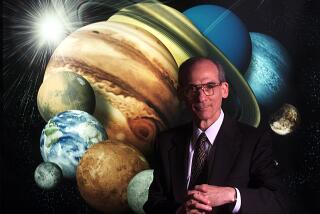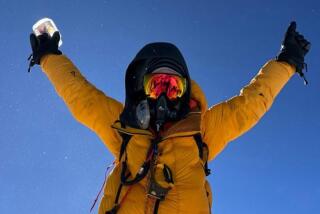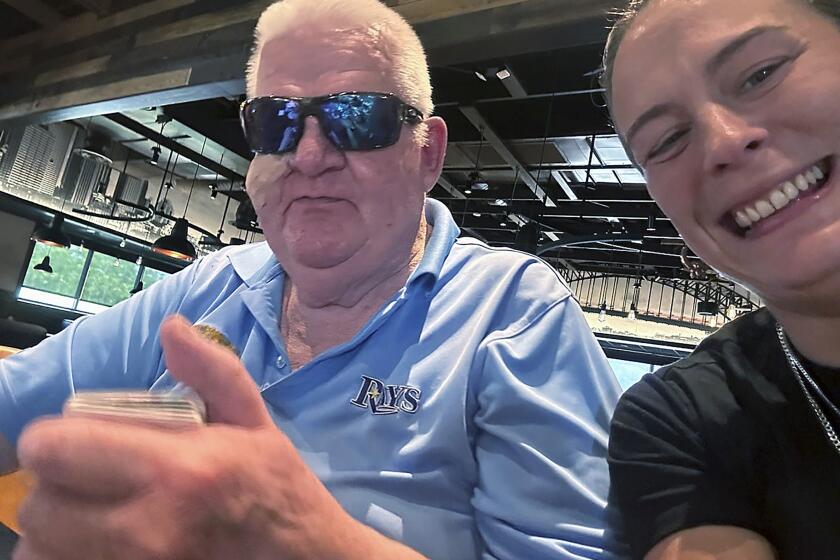The Ultimate Red-Eye : Two Pilots Steel Themselves for Their Round-the-World Endurance Test
By the third night, Dick Rutan knew he had to get some sleep.
After one false start that had ended with an emergency landing, Rutan and Jeana Yeager had taken off at 2:52 p.m. on July 10 for a shot at a world record in their experimental plane, the Voyager.
Their immediate goal was to fly the spindly aircraft farther in a closed loop than anyone had ever flown before. That would put them in the record books and move them a step closer to their ultimate goal: flying around the world without stopping or refueling even once.
But just a few hours into the July flight, they had already plenty of cause for second thoughts about the chances of completing a round-the-world flight of almost 12 days, scheduled for sometime next month.
They earlier had flown 47 trial flights, none of more than two days’ duration. None had tested the pilots for this five-day flight up and down the Pacific Coast.
Noise was their constant companion, sleep their potential executioner.
The Voyager is an awkward beast, designed for the single purpose of an austere trip around the globe. Its disproportionate wingspan (110.8 feet) enables it to carry more than four times its weight in fuel (1,500 gallons weighing almost 9,000 pounds), but as a result the aircraft is difficult to maneuver. The plane carries two people but has a seat for only one. While one person pilots, the other lies flat in a cramped area not much bigger than the front seat of a standard passenger car.
For the pilots, even changing places is a monumental chore. The cockpit is only four feet wide at its widest point and seven feet long--and some of the room is taken up with instruments and controls. The 6-foot-2 Rutan would push the seat back as far as it would go, while Yeager, a 5-foot, 4-inch whisper of a woman who holds seven flying records (she is not related to famed test pilot Chuck Yeager), slid onto a small shelf along the left side. “I would roll out to the left while Jeana stayed on the shelf, and then slide back into the bunk,” he said.
In theory, that should have permitted one person to sleep while the other flew. But the arrangement left Rutan with his head banging against the bulkhead that separates the cockpit from the four-cylinder, 100-horsepower aft engine. (A forward engine is used only on takeoffs.) On the ground, the Voyager doesn’t sound much noisier than a small car. But to a pilot pushed against the engine, the drone becomes an inescapable roar.
“The Voyager was not constructed with any consideration to noise abatement, and you’re sitting on the engine,” Rutan recalled. (Helmets similar to those worn by the Apollo astronauts are being designed to protect the pilots’ hearing.)
The pilots had decided that Rutan--who had flown hundreds of combat missions over Vietnam--would fly at night, Yeager during the day. Pilots grow tired very quickly at night, and even minor problems can take on seemingly horrifying dimensions. Rutan wanted that duty himself.
All day and through the first night, the plane droned up and down the coast between San Luis Obispo and San Francisco at just less than 100 m.p.h. The goal was to trace the route 20 times, covering more than 11,000 miles and breaking a 1962 distance record and an endurance record of 84 hours set in 1931.
The plane is flown on automatic pilot once it reaches cruising altitude, because the pilots quickly would become exhausted if they had to constantly fight to control the plane. Even so, both pilots had their hands full.
“The flight was not just to set a world record,” Rutan explained. “The majority was for data acquisition.” That meant filling out endless paper work. They kept records of everything they ate or drank, when they went to the bathroom, when they slept. In an effort to determine their psychological adaptability to the ordeal, both pilots continually jotted down their feelings about how the flight was going. In addition, they constantly recorded instrument readings and logged all radio communications.
The first day breezed by, filled with excitement. Rutan piloted all day and through the night, and the next morning turned the controls over to Yeager. As he contorted his way into the bunk, he met the real enemy:
“I couldn’t sleep.”
The bunk was so small that Rutan had cut off the end of an air mattress to make it fit. But he had not sealed the cut adequately, and the air quickly escaped. Yeager had brought a few pieces of foam aboard, and Rutan slipped them under the mattress. “But every time I would shift a little, my hip would slide off and bang into the floor,” he said.
Always there was the noise, a sickening thunder roaring in his ears from an engine literally inches away. And his body rebelled.
“Your body has to believe it is secure,” Rutan said. “It’s difficult to go to sleep if you think you are going to die in a few minutes. After a few hours, you’re just a vegetable.”
Hours passed, but sleep wouldn’t come. The next day, fatigue and the cramped quarters magnified their chores. It took half an hour just to change their clothes.
On the second night, Rutan battled to stay awake at the controls. Rutan knew it was more than just a war against sleep. “You’re just fighting to stay alive.”
When the sun finally rose, “I turned Jeana loose and it was sink or swim,” he said. He crawled into the bunk again and somehow was able to block out the engine noise. He slept for 10 hours.
Even so, sleep continued to be a problem. “Sometimes, while flying at night, I would need a little sleep,” Rutan said. “I would lay my head back, and she would monitor the instruments while I got an extra shot to finish the night.” Yeager, who easily fit into the bunk, never had much of a problem.
All of their food was wrapped tightly in aluminum foil, and they had expected to eat cold meals. But they soon found that an aluminum pipe that channels warm air from the engine compartment into the cockpit was always hot.
“I found I could wrap the foil packets around the pipe, then wrap a towel around it for insulation and heat the food,” Rutan said.
Rutan, who loves chicken soup, was surprised to find that he could not stomach it aloft. Bland foods have a way of becoming spicy at higher altitudes, he said, making even mildly spicy foods inedible. (Yeager had little appetite. Back on the ground, she collapsed from dehydration.)
Liquid wastes were discarded through a tube with a cup on one end; solid wastes were packaged in plastic bags. “Our original plan was to throw the bags overboard,” Rutan said. “But we couldn’t fit them through the hole (in a window).” The bags stayed.
In the end, Rutan said, the flight couldn’t be called fun. “It’s damn hard work, and you’re very uncomfortable.” Still, they adapted, and “by halfway through we felt very secure. That was our home, our world.”
At 6:37 a.m. on July 15, after flying 11,857 miles in 111 hours and 44 minutes, the Voyager landed in Mojave. It had enough fuel left for a trip from New York to Paris.
The September trip is to take 11.8 days, with the plane dipping under the southern tip of Africa and flying over Australia and Hawaii.
While the course is mostly over water and is designed for favorable weather, no one is sure how the plane, built of super-light carbon graphite, will perform in turbulence. And there are worries about the durability of its propellers. Results of a post-flight inspection, Rutan said, “were not very encouraging.”
Even so, Rutan is determined.
“If you are an individual with an opportunity to accomplish a major milestone in your chosen field . . . it grips you. You can’t walk away from it.”
More to Read
Sign up for Essential California
The most important California stories and recommendations in your inbox every morning.
You may occasionally receive promotional content from the Los Angeles Times.










